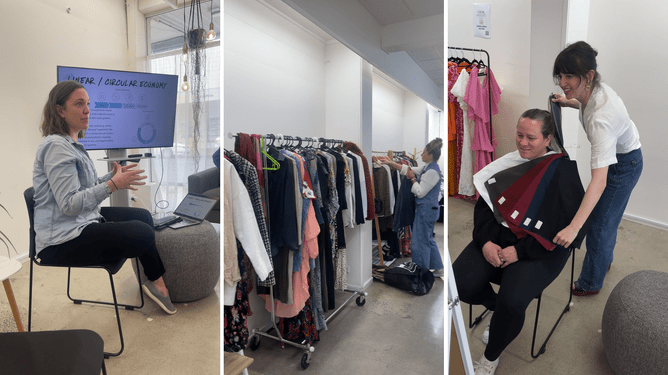Whether we realise it or not, we’re all major players in the fashion industry … just by wearing clothes every day. But behind that simple act is a huge environmental cost - including water pollution from dyeing processes, the carbon footprint of fast fashion production, and the mountains of textile waste that are piling up in landfills globals. That’s why the shift to sustainable fashion is so urgent - and luckily, we all have the power to make a difference by thinking more consciously about our clothing choices.
Last weekend at our South Waikato Hub, we brought the community together to rethink our wardrobes, and explore the small, mindful moves we can make to embrace more planet-friendly fashion choices.
Here are five essential tools for more sustainable fashion that we explored:
1. The Buyerarchy of Needs
Have you ever heard of this concept? This six-step flowchart is a great tool for encouraging a mindful approach to clothes shopping. It helps us differentiate between shopping out of genuine need versus fleeting desire and urges us to explore alternative options before making a purchase.
The six steps of the Buyerarchy are:
Identify Your Need: Before making a purchase, ask yourself what you truly need. Consider clearly whether this is a genuine need, or a fleeting want.
Look for What You Already Have: Before heading out to shop, check your wardrobe first. You might find that you already own something that fits the occasion. This not only saves money but also reduces waste by maximising the use of what you already possess.
Borrow or Swap: If you can’t find what you need, consider borrowing from a friend or family member or friend. This allows you to enjoy “new” pieces without adding to your wardrobe permanently, making it a great way to refresh your style sustainably.
Repurpose or Upcycle: Get creative with your clothing! Transform items that no longer serve you into something new and exciting. This could mean turning old jeans into a tote bag or reworking a dress into a skirt. Upcycling can extends the life of your clothes and be a fun way to showcase your personal style.
Buy Secondhand: If you still find you need something new, consider shopping at thrift stores or online secondhand marketplaces. Buying pre-loved items reduces the demand for fast fashion, minimises waste, and often uncovers unique pieces that add character to your wardrobe.
Buy New (if Necessary): Finally, if all else fails and you still need something new, make sure to invest in high-quality, ethically produced items. Look for brands that prioritise sustainable practices, transparency, and fair labour. By supporting these companies, you're contributing to a more responsible fashion industry.
2. Capsule wardrobes
A capsule wardrobe is a fantastic tool for sustainable fashion.
It consists of a streamlined collection of clothing designed to maximise outfit options while minimising clutter. This approach encourages you to curate a selection of essential pieces that work well together, allowing for countless outfit combinations without the overwhelm of an overflowing closet.
To start building your capsule wardrobe, assess your current clothing collection and identify the key pieces you wear regularly. Consider what you truly need to fill any gaps in your wardrobe. Aim for a balanced selection of tops, bottoms, dresses, and outerwear that can be mixed and matched for various occasions. This strategy can simplifies your daily routine and encourages a more sustainable approach by reducing impulsive purchases.
3. Thrift shopping
Thrift shops are an excellent resource for sustainable shopping. These stores represent a more ethical way to shop, allowing consumers to make environmentally conscious choices.
When we choose to spend our money at thrift stores, we’re supporting sustainable practices and helping shape the future of fashion.
Plus, they’re filled with tons of hidden gems that are waiting to be discovered (we had a number of local thrift stores showcasing their collections at our event, which were a testament to that).
4. Clothes swapping
Clothes swaps are another fun and engaging way to refresh your wardrobe sustainably.
One of the highlights of our Sustainable Fashion Day was our clothes swap, where participants exchanged pre-loved clothing for "new-to-you" items. This simple yet enjoyable activity allowed attendees to extend the life of garments while reducing waste.
Among us, we shaped 36 items. According to Faretech’s Fashion Footprint Tool, that’s equivalent to saving:
390.7kg of CO2 savings
9.1kg of waste diverted from landfill
11.7m3 of water savings
9 years of drinking water for one person
11.7kg of chemicals prevented from entering the soil
39.7 trees absorbing CO2 for a year
The term ‘circular fashion economy’ might sound intimidating - but in practice, it’s pretty simple. There are lots of simple tools - like capsule wardrobes, thrifting, clothes swapping - that empower us to push back against fast fashion, and enable us to shift away from the traditional "take, make, waste" model. These actions are a reminder of how small, community-driven actions can lead to significant environmental benefits.




